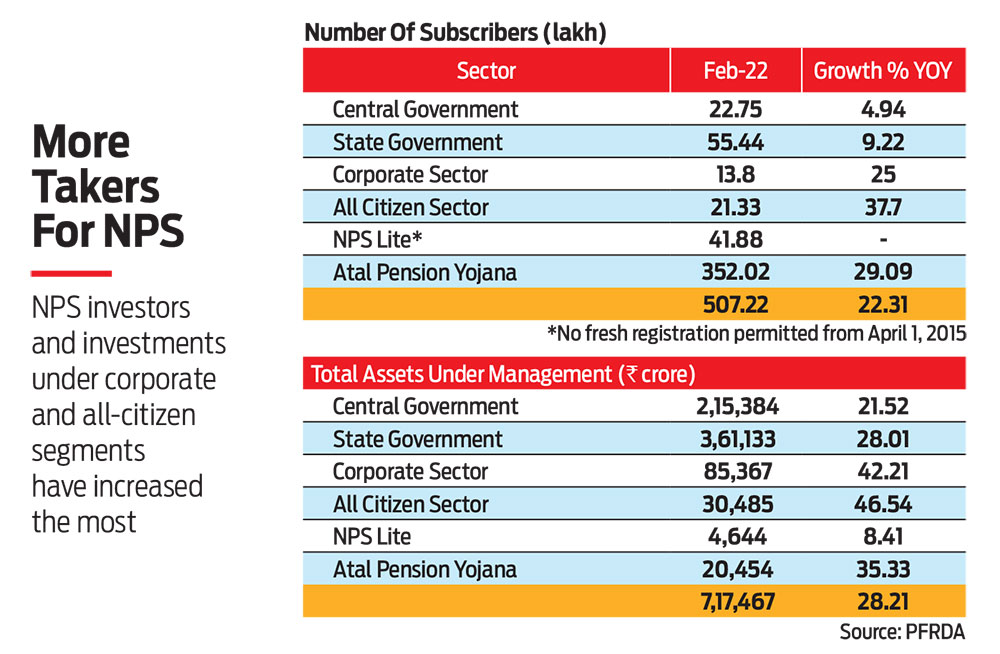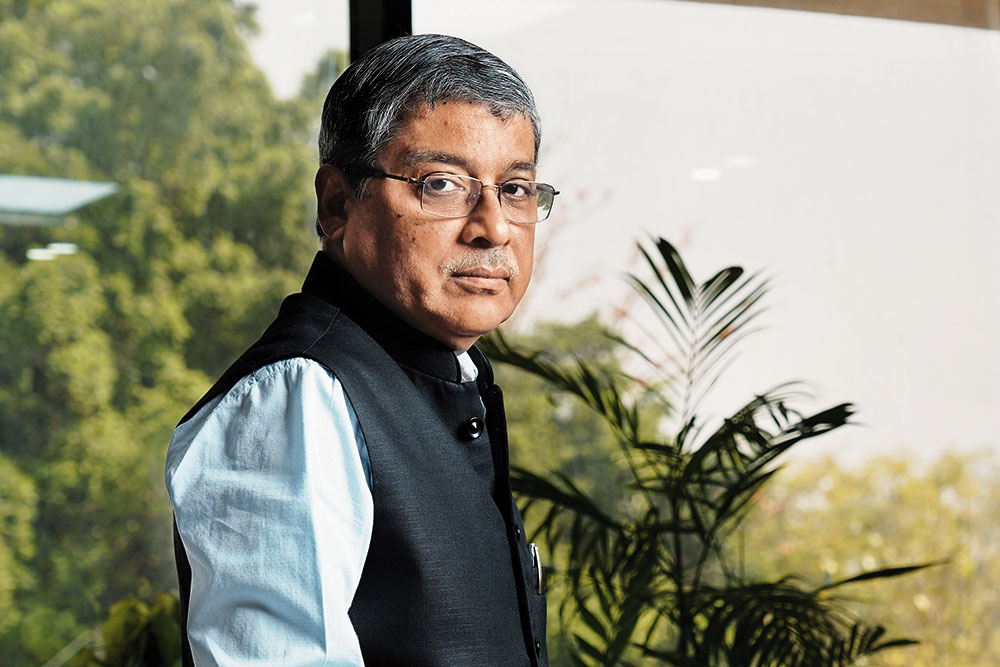The National Pension System (NPS) has undergone many changes since inception to cater to the needs of the retired. That said, it is still a work in progress in many ways. One of the biggest changes set to take place is the expansion of the equity basket in the Tier II account of NPS to 100 per cent from the present 75 per cent. Further, NPS seeks to settle the debate on assured returns with a new product that it plans to launch in 6-8 months. Plans are also afoot to come up with options for annuity products. At present, subscribers are mandated to buy annuity using 40 per cent of the retirement corpus. But low returns and lack of tax efficiency make them unfavourable.
In an interview with Outlook Money, Supratim Bandyopadhyay, chairman of the Pension Fund Regulatory and Development Authority (PFRDA), which regulates NPS and the Atal Pension Yojana, spoke about changes that are in the offing that may make NPS a suitable retirement saving option for subscribers. Edited excerpts:
There has been a lot of debate in states regarding the old pension scheme and the National Pension System (NPS). What’s the difference between the two?
These schemes are not really comparable with each other. The earlier scheme was a defined benefit scheme under which, at the time of retirement, say, 50 per cent of the last-drawn salary would be given out as pension. It had no funding concept. NPS, which the government introduced in 2004, was conceptualised as a defined contribution system, where both the employer and the employee know about the financial commitment in advance.
About 18 years down the line, we see that many countries have shifted from defined benefit schemes, akin to our old pension scheme, to defined contributions schemes like NPS. The old pension schemes were not funded, so the money was going from the government’s coffers. But this became financially unsustainable. Now, we have a retirement product that is sustainable.
But the old pension scheme gave some guarantee in terms of income. What about NPS?
The defined contribution system (NPS) does not give a guarantee, but it does guarantee that there will be a pension at a later point. Also, it does not create an unusually high financial burden on the government. Within NPS, we are trying to create another scheme, which will be a minimum assured return scheme. We have already engaged a consultant for that.
Can you give us the contours of this new product? When is it expected and what kind of guarantees will it provide?
The PFRDA Act, which came out in 2013, mentioned a minimum assured return product. So, we have been working on it for quite some time. We initially discussed it with pension fund managers (PFMs), but realised that PFMs can only give capital guarantees and no subscriber will really come only for capital guarantees. So, we brought in a consultant, an actuarial firm. The product will be there in the next six-eight months.
It is difficult to say at this point of time what kind of guarantees it will provide. However, we may have a floating kind of guarantee, and not fixed. Here’s the reason: Telling the subscriber that we will give 5 per cent when government bonds are giving 7 per cent is okay, but when returns from government bonds will come down to 6 per cent or 5.5 per cent, then it will be very difficult to maintain that 5 per cent guarantee. So, instead, we are thinking of a floating return, which will vary maybe according to market benchmarks like one-year Treasury bill (T-Bill) or one-year government bond, and it will be reset every year. I believe it will be an interesting product and appeal to the customers.
Will the new product settle pensioners’ anxiety and the debate about guarantees to some extent?
I believe so. Normally, a lot of people look for guarantees. In my earlier experience with the insurance industry, whenever we came out with guarantees, we saw a huge response. For a section of pensioners, who do not want any uncertainty in their portfolio, this will come as good news.
Many subscribers are concerned that 40 per cent of the proceeds at the time of maturity needs to be annuitised. The annuity products in India at present are not efficient in terms of taxability as well as the rate of return. Does PFRDA plan to look at other more efficient options?
First of all, let’s understand why we have annuities. That’s because they ensure that there is regular income after retirement. If it was some other scheme, we could have given the entire corpus at one go, or, provided early access to funds in a big way. But since this is a pension scheme, we need to ensure that it provides some regular income.
I understand that the income from these annuities are taxable in the hands of the investors and that could make it difficult for pensioners to manage their expenses. But, yes, in the draft PFRDA Amendment Bill, we have proposed other annuity payout options. So, there will be other options available as and when it gets passed by Parliament.
One issue with annuities is that the rate of return is very low. At present, the annuity at the age of 60 years, which assures that the corpus will come back to the legal heir or nominee, gives a return of just about 6 per cent. And, once it gets fixed, it remains so (for a particular subscriber). These annuity rates vary according to the interest rate situation in the market, and can be even lower (for others).

Though the 60 per cent lump sum that can be withdrawn at the time of retirement is now tax-free, the annuity income is taxable. Isn’t it high time that NPS becomes more competitive, especially when compared with other retirement products like Employees’ Provident Fund (EPF) or Public Provident Fund (PPF), which enjoy the EEE (exempt-exempt-exempt) status?
In a way, NPS also enjoys the EEE status. The only thing is that the entire corpus is not paid out. The 60 per cent lump sum that is given in the hands of the retired person is tax-free, but the 40 per cent that goes into buying annuities doesn’t incur any GST. There is no TDS either. If you buy an annuity product from an insurance company, it will have a GST impact of 1.8 per cent.
The outcome of the annuity is taxable. But, even in EPF, once the amount is paid, it needs to be reinvested somewhere by the retired person and those returns entail tax. The only thing is that you do not get 100 per cent of the money in NPS at the time of retirement.
Talking about specific tax benefits of NPS, there is one exclusive tax benefit under Section 80CCD (1b), which gives an additional benefit of Rs 50,000 if you invest in Tier 1 account.
Apart from that, there is a benefit under Section 80CCD (2) also. Here, if the employer also contributes to NPS Tier 1—up to 10 per cent of the basic income—it is not taxed in the hands of the employee as perquisite, and even the employer gets a tax benefit, as it comes under business expenditure.
NPS has undergone many changes since inception, including the tax-free status for the 60 per cent lump sum. What key things can subscribers look forward to now?
NPS has added numerous flexibilities over time, such as the number of investment options. If someone’s risk appetite is high, say, at the age of 25-30 years, they can invest up to 75 per cent in equity. Similarly, if someone wants to stay safe, they can put even 100 per cent in government securities. You can switch between investment options. Earlier, there were two opportunities in a year to switch; now it is four. If you are unhappy with the fund manager, you can change the fund manager once a year. We have increased the entry age from 65 to 70, and you can stay invested till the age of 75. After we increased the age band five months back, more than 2,000 people in the age group of 66-70 years have joined NPS, which shows that there is demand.
We plan to bring in one more change, subject to board approval, in the Tier II account, which is optional, and gives a lot of flexibility. We will allow people to take up to 100 per cent equity exposure. This is in keeping with customers’ requests. People who have high risk appetite and want to invest heavily in equity will get that flexibility in the Tier II account.
As of now, the biggest issue we encounter is lack of awareness about retirement income and old-age security. Normally, young people do not like to discuss or think about these issues, and assume that the conversation can be postponed. But people need to know that there is huge longevity risk. People who are retiring at 60 years are living for another 18-20 years on an average. But there are costs associated with longevity that people have to encounter after retirement when the salary cheque stops coming. One has to be prepared for that, and with the joint family system now breaking down, I believe everybody is on their own, and we have to start now and start early.
nidhi@outlookindia.com







